Back to database
Erma
EMP submachine gun
[DE]
Maschinenpistole Erma
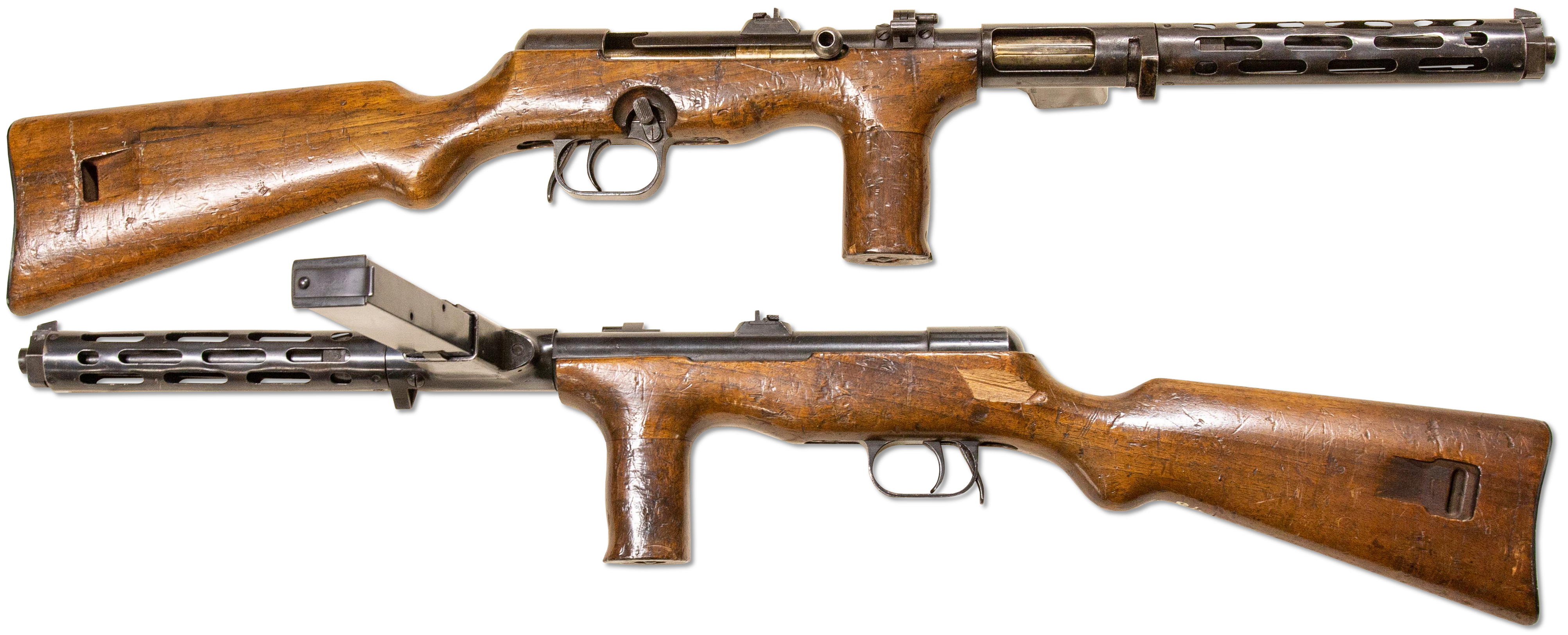
(Author's photo via Royal Armouries Collection)
The EMP
submachine gun had a long development that began in the mid-1920s. The
basic design of this gun was the work of the prolific armaments engineer
Heinrich Vollmer, who started his own small firm after World War I. Many
large arms companies were prohibited by the Treaty of Versailles from
producing machine guns, although contrary to popular belief, the issue
of submachine guns for the German Army was not actually banned; rather,
the Reichswehr was restricted to issuing only 1,137 light machine guns,
automatic rifles, and automatic carbines (SMGs likely fell under the
latter category, as they are never actually mentioned in the treaty
itself). However many German arms companies were restricted from
manufacturing automatic weapons, with only a few exceptions. In 1925 the
Reichswehr funded the development of several new submachine guns for
comparative trials. Vollmer was one such recipient of this military
funding and that year he demonstrated to the Heereswaffenamt
(HWA) a new
submachine gun which was known as the VMP (Vollmer
Maschinenpistole).
The initial prototype of the VMP resembled the Bergmann M.P.18,I, with a
tubular receiver, wooden stock, jacketed barrel, and small-capacity drum
magazine. It was distinctive, however, by a large fore-grip built into
the stock. The internal operation of this weapon was, like the Bergmann,
a rather basic open-bolt blowback action, reciprocating against a
thin-diameter recoil spring on a guide rod. This prototype was tested at
Kumersdorf in August of 1925 and several complaints were raised against
it, particularly criticisms of the drum magazine, which was difficult to
load, and the recoil spring. Nonetheless, Vollmer was granted continued
funding by Lt. Col. Eckardt of the HWA and development continued.

The
first model Vollmer, feeding from a drum magazine, tested in August
1925.
In 1926, the second model Vollmer appeared. This improved prototype
established many of the design traits that would become constants in
future models of the VMP. This added a Bergmann-type bolt retaining notch in
the cocking slot, and a distinctive lever located behind the trigger
which, when pulled back simultaneously with the trigger, would unlock
the receiver from the main body of the gun for easy disassembly.
The drum magazine was, curiously, retained despite its issues, though in
1927 it would be abandoned for good in favour of a simpler 32-round box
magazine. The magazine well was canted forward slightly to assist the
transfer of cartridges from the magazine to the receiver.
The VMP 26 was tested, inconclusively, by the HWA, and the initial
interest in Vollmer's submachine gun petered out as the Reichswehr
issued no official requirement for a service submachine gun at this
time. Small quantities of VMPs were delivered to Russia and Bulgaria for
trials in 1927, but were not adopted in either country. Production of
these early trial guns was apparently undertaken through several
subcontracted companies, while the guns themselves were assembled by
hand in Vollmer's own workshop. By 1930, Vollmer had developed the
finalized version of the VMP submachine gun. This was essentially
similar to his model of 1927 but employed a new, innovative recoil
spring design. The recoil spring was housed within a compartmented,
telescoping sheath which carried the firing pin. This ran through the
bolt and acted as a buffer. Vollmer's telescoping mainspring system
would famously be carried over into the later MP 38 and MP 40 submachine
guns, however it originated here in the VMP.
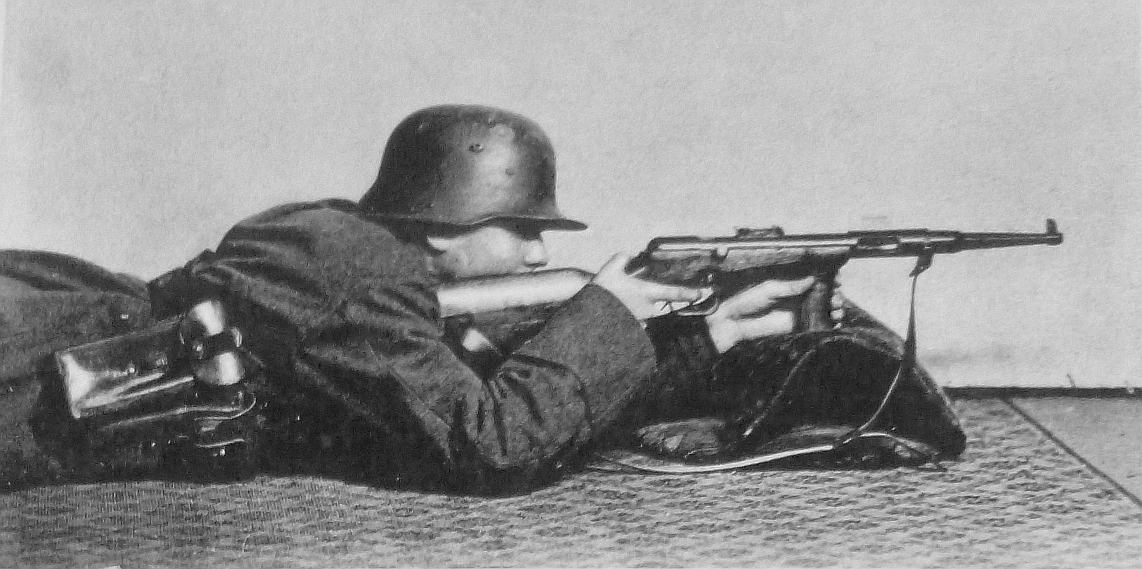
An interwar Reichswehr soldier
demonstrating the VMP 30 submachine gun.
The VMP 30 was marketed, and probably produced, through the Will &
Köhler company in Thüringen. This small company predominantly made
airguns and pocket pistols, and so was probably not subject to any of
the restrictions on the manufacture of machine guns that bigger arsenals
were. The VMP 30 was tested by the HWA in 1933 but again, there was
little interest in adopting this weapon. Some guns were also delivered
for export in Norway, though less than 1,000 guns were actually made -
the total output has been estimated at 350 - 400. By 1934, Vollmer had
transferred the rights of the VMP to Erma-Werke in Erfurt. The Nazis
were now in power and the Versailles restrictions were all but
abandoned, meaning large-scale production of machine guns and submachine
guns recommenced. The deal between Vollmer and Erma was reportedly
brokered on October 20th 1931, although manuals for the VMP continued to
be printed by Will &
Köhler until 1933 so it must be assumed that production at
Erma did not commence until 1934.
Under the direction of Berthold
Geipel, Erma-Werke produced the Vollmer submachine gun for commercial
sale as the EMP (Erma Maschinenpistole).
This was Erma's first submachine gun. The design was essentially the
same as the VMP but some slight modifications were made, including the
addition of a barrel jacket with rectangular perforations, and the
elimination of the monopod. Erma commenced production of the EMP in 1934
and marketed it for domestic and export sale.
The EMP submachine gun was produced in two forms. The early models were
made with an adjustable tangent rear sight, unchanged from that of the
VMP. The first 2,000 - 4,000 guns were made in this pattern. However the
later production model, which accounts for the vast majority of
German-made EMP submachine guns, replaced the rear sight with a flip-up
notch sight, somewhat similar to that of the Bergmann M.P.18,I. These
late production guns were also fitted with forward safety switches which
locked the bolt in the closed position; these were mandated by the
German police for fixture on the EMP and M.P.18,I submachine guns. Some
variant models of the EMP were also made, including a long-barreled
export version with a bayonet catch, and a version with a flat stock,
with no fore-grip. These were only made in very small numbers and were
not commercially successful.

An
EMP with flat fore-end. A single example of this exists in the US; it
is
not known how many of these were produced.
Prior to the outbreak of World War II, the EMP was a relatively
successful export. Sales were reportedly made to Mexico and Yugoslavia.
The actual commercial success of this weapon outside of Germany is,
however, probably overstated by most sources, as it is commonly assumed
that the largest sales were made to Spain and France, which is not
actually true (see below sections). Probably the first conflict in which
the EMP was used in combat was the Chaco War (1932 - 1935), during which
German arms deals to Bolivia resulted in the supply of small quantities
of EMP submachine guns, along with the Haenel M.P.28,II and
Steyr-Solothurn S1-100. The EMP was not adopted by Poland but was used
as the basis for their own submachine gun, the Wz.39 Mors. Production of
the EMP was suspended in 1938, when Erma introduced the cheaper MP 38
submachine gun, which was officially adopted by the Wehrmacht and given
far greater priority than the EMP.

An EMP submachine gun used during the
Chaco War (1932 - 1935).
Early in World War II, the EMP was pressed into military service to fill
shortages of submachine guns. They were typically not issued to
frontline Wehrmacht battalions but instead reserved for rearguard
personnel such as military policemen. The main adopters of the EMP were
the Waffen-SS, who used this gun in large numbers throughout the war.
The SS most likely sourced their EMPs through existing police stocks, as
the majority of their guns were fitted with the police-issue forward
safety lock. It was very commonly seen in issue by the SS on the Eastern
Front, and was unfortunately favoured by Einsatzgruppen
death squads. Probably about 20,000 guns had been produced from
1934 - 1938, with serial numbers exceeding 17,000 having been observed.
The EMP in Spain - myths and facts

The
Spanish EMP. The examples made in Barcelona were in 9mm Parabellum and
those made at Coruña
were chambered in 9mm Largo.
(Author's photo via Royal Armouries Collection)
The EMP received its baptism by fire during the Spanish Civil War (1936
- 1939), where it was used extensively in combat for the first time.
When the Republic collapsed and the war ended in 1939, the remnants of
the Republican People's Army fled to the French border where they were
disarmed by the authorities there. The French arms depots collated some
3,250 EMP submachine guns from the retreating Republicans - probably the
largest quantity fielded by any army in the world at this time. But how
did the Spanish Republicans acquire these weapons?
Various theories have been posited. The most common assumption is that
EMP submachine guns were sent by the Nazis to their Francoist allies,
and some of these guns were captured in battle by the Republicans. This
has, however, been essentially proven false by Spanish experts, who have
found no evidence that the Nazis ever supplied any great quantity of
submachine guns (estimated at 170 at the very most). Paul Preston, in
his authoritative book Arms For Spain
on the subject of arms trafficking during the Spanish Civil War,
suggests that the EMPs were sold to the Republicans by the Polish
government. But there are no records of these apparent Polish sales, and
it seems highly unlikely that Poland would willingly have discarded over
3,000 submachine guns at a time when their army was considering the
adoption of an SMG. Another suggestion is that they were supplied by the
Soviet Union as part of their material aid for the Spanish Republic, and
this theory is apparently supported by close relationship between the
'Black Reichswehr' and the Soviet Union at the time that Vollmer's VMP
was being tested. But again, there is no record of any EMPs being
supplied by the Soviets, and even in spite of Vollmer's dealings with
the USSR, it is highly unlikely that the Soviets had such a large
quantity of EMPs - at best, they have a small number of the earlier VMP
that had been trialed in the 1920s and early 1930s.
The true answer is actually far more simple. These EMPs did not come
from Germany, Poland, or the USSR. In fact, they were produced
domestically in Spain by the Republican government. In 1937, manufacture
of the EMP submachine gun was established by the Subsecretaría
de Armamento y Municiones in Barcelona. These guns were very
close clones of the early model EMP, with an adjustable tangent rear
sight, and were probably copied from trial samples which had been sent
to Spain before the Civil War. However, they also exhibited several
slight deviations from the German originals which make them easily
distinguishable:
- A solid, oval-shaped cocking
handle, as opposed to a round cocking handle with a hollow hole in
the
middle,
- 'T - A' marked on the fire
selector switch (for 'Tiro-a-Tiro'
and 'Automática'), as
opposed to 'E - D' ('Einzelfeuer'
and 'Dauerfeuer'),
- No Erma-Werke factory
markings, only a crudely-stamped serial number on the magazine well
and
receiver.
Several thousand EMP submachine guns
were produced by the Subsecretaría de Armamento
from about 1937 - 1939. It is probable that the 3,250 guns confiscated
at the French border represented the great majority of the total
production output. After the fall of the Republic, the new Francoist
government captured the machine tools used to manufacture the EMP in
Barcelona and transferred them to Coruña Arsenal. Here, they were used
to produce the M41 submachine gun, which was identical to the Republican
EMP except for the chambering, which was changed to the standard Spanish
pistol cartridge 9x23mm Largo. Therefore neither the Republicans nor the
Francoists actually acquired a license to build the EMP from Erma-Werke
- all Spanish versions were unlicensed copies. Production of the M41
submachine gun exceeded 10,000 units, meaning that roughly a third or
more of the total number of EMPs manufactured are actually Spanish
copies.
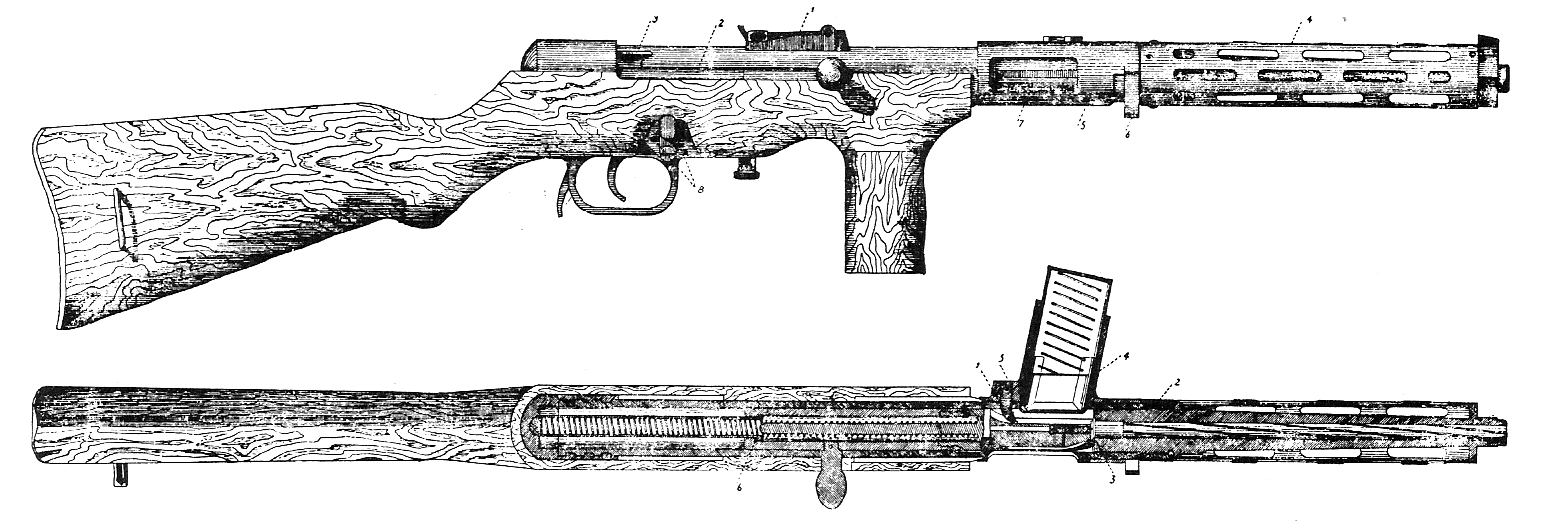
The
Coruña
Arsenal M41/44 submachine gun, a modified version
of the Spanish M41.
Note the plunger safety in front of
the trigger guard.
In 1944, an improved version of the M41 was developed at Coruña Arsenal, known as the
M41/44. This introduced a plunger-type safety located on the underside
of the receiver, which, when pressed up, would prevent the bolt from
reciprocating. This was designed in response to sometimes-fatal
accidents involving the EMP discharging by itself. It must be remembered
that, while the vast majority of German-made EMPs were fitted with
forward bolt locks, this feature was not present on the Spanish EMP and
therefore they had to invent their own bolt lock. The M41/44 succeeded
the standard M41 in production, until the EMP was replaced by more
modern submachine guns in the 1950s and 60s. Beyond the plunger safety,
M41/44 submachine guns are identifiable by a unique marking - 'CAL.9L'
is marked in a cartouche on the magwell, which imitates the 'ERMA'
cartouche on the original EMPs.
The EMP in France
As has already been established, over
3,000 Spanish-made EMP submachine guns ended up at the French border
after the end of the Spanish Civil War in 1939. When the Second World
War broke out later that year, the French Army was lacking a submachine
gun - they had adopted the MAS Mle 38 the previous year, but it was not
yet in full-scale production and barely any guns had actually been
issued. Thus when Germany invaded in 1940, the French Army pressed these
Spanish EMPs into emergency service, predominantly with the 'Corps
Francs' special commando units, however they had a
disproportionally small number of magazines and therefore not all 3,250
guns could actually be used.
Although it has been claimed that the EMP was "exported" to France
during the interwar period, France purchased no guns from Germany,
except perhaps a small number of samples for their submachine gun trials
in the 1930s. All French-service
EMP submachine guns were Spanish-made, from those stocks confiscated in
1939. This is nowhere better demonstrated than in the French Army's
official instructional pamphlet for the EMP submachine gun - known in
service as the 'Erma-Vollmer' - which clearly depicts a Spanish clone
with an oval-shaped cocking handle and 'T - A' inscribed on the fire
selector. All known photographs of French soldiers using the EMP also
depict the Spanish version. Thus the idea that the EMP was exported in
great numbers to Spain and France is false.
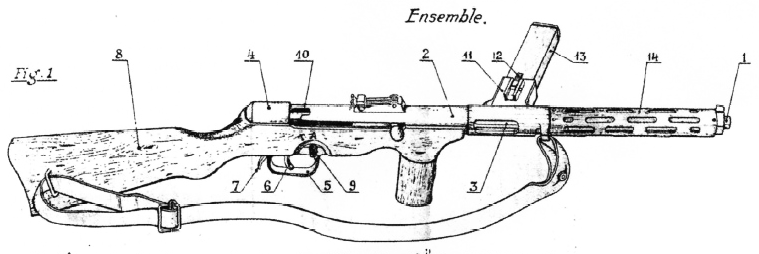
Sketch from a French manual showing
the 'Pistolet-Mitrailleur Erma-Vollmer'. It can
clearly be seen that this is a Spanish model, with 'T - A' on the fire
selector.
After France's defeat in 1940, many of these Spanish-made EMPs fell into
German hands. They were not classed simply as standard EMPs by the
Germans but actually re-designated as the 'MP 740(f)'. Owing to their
familiarity with the EMP, some of these guns were distributed to
Waffen-SS forces to compliment the existing supplies of German EMPs. But
the majority remained in France, and were used by Vichy troops,
Gendarmes, and collaborationist auxiliaries in the German occupation
zone such as the Carlingue.
After the war, they remained in use by the Gendarmerie
for a time, before fully being phased out by the 7.65mm MAS Mle
38.
The mysterious 'silent' EMP

The suppressed variant of the EMP,
allegedly produced in small numbers for the Brandenburger division and
Carlingue.
(Author's photo via Royal Armouries Collection)
A small batch of EMP submachine guns fitted with sound suppressors are
known to have been produced, but the details surrounding these guns are
obscure. According to Russian sources, these were fielded on the Eastern
Front by the Brandenburger division,
an elite Abwehr unit who conducted sabotage and anti-partisan operations
behind enemy lines. A sample was captured and examined by the NKVD at
the end of 1941. This weapon, which apparently predates the silenced
Sten gun used by British Commandos, motivated the Soviets in turn to
develop their own silenced submachine gun, but their efforts ended up
being unsuccessful.
One of these guns also exists in Britain, and is said to have come from
France where it was apparently used by the Carlingue
against French resistance fighters. Examination of this sample has
revealed that the sound suppressor is of poor design, as it does not
actually slow the bullet's exit from the muzzle and therefore it is not
subsonic - i.e. the bullet velocity is not below the speed of sound, and
therefore the gunshot is still highly audible and the suppressor has no
real appreciable effect. It is possible that the gun was to be issued
with a modified subsonic cartridge, but again the details have been lost
to time and there is no definitive provenance for the manufacture of
these guns. The substandard workmanship of the suppressors suggests,
though, that they were probably not made at Erma-Werke.
Gallery
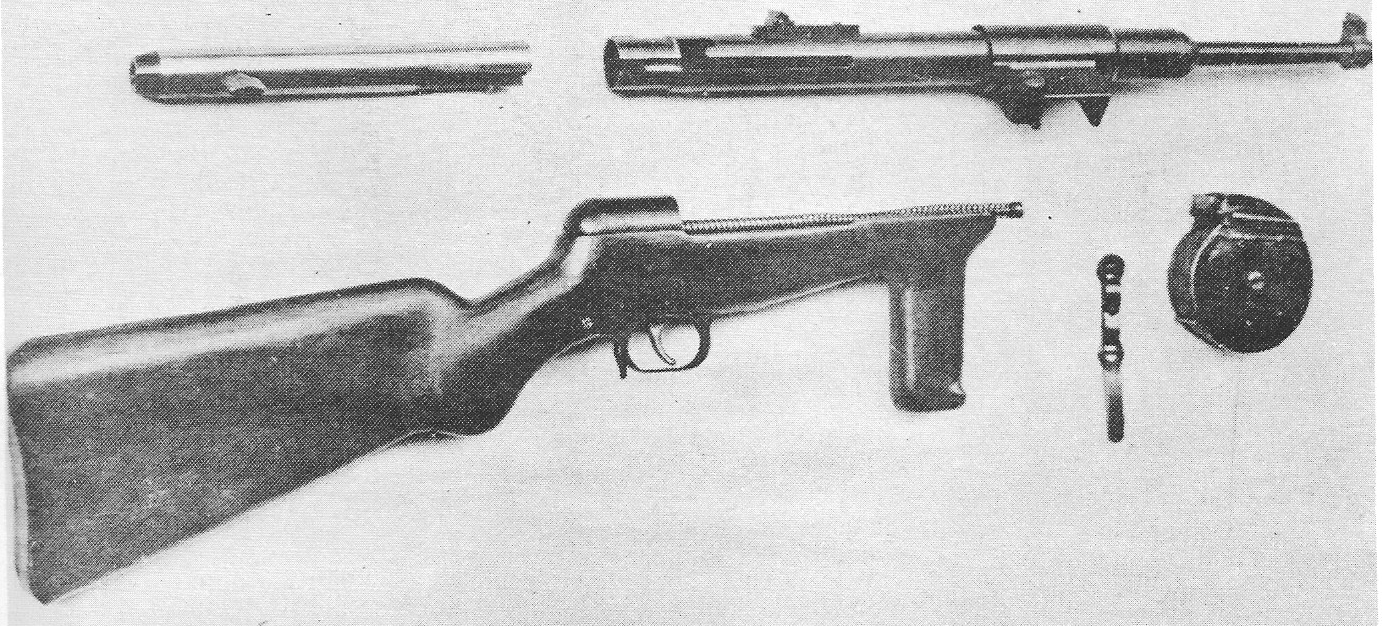




Back to database














